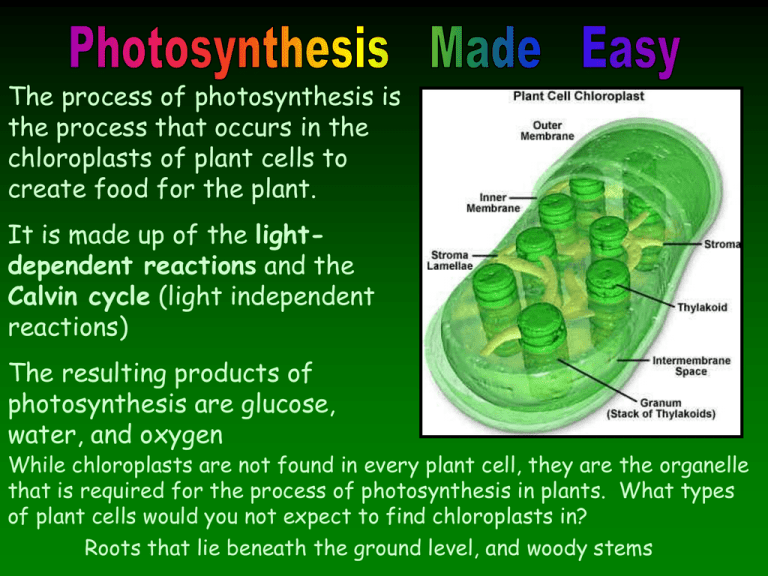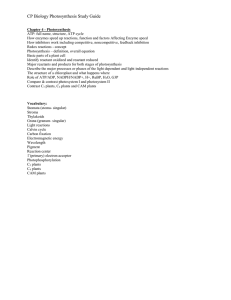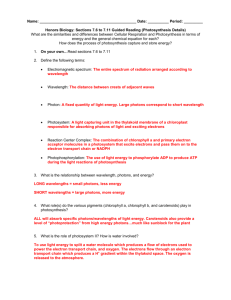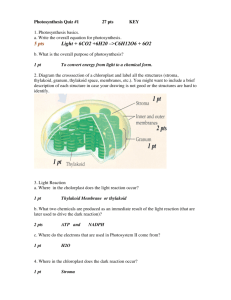Calvin cycle
advertisement

The process of photosynthesis is the process that occurs in the chloroplasts of plant cells to create food for the plant. It is made up of the lightdependent reactions and the Calvin cycle (light independent reactions) The resulting products of photosynthesis are glucose, water, and oxygen While chloroplasts are not found in every plant cell, they are the organelle that is required for the process of photosynthesis in plants. What types of plant cells would you not expect to find chloroplasts in? Roots that lie beneath the ground level, and woody stems Talk to your partner about what the two parts of photosynthesis are known as. ANS: light dependent; light independent (or Calvin Cycle) Talk with your partner about the products of photosynthesis. ANS: Glucose; water; oxygen The chloroplasts, where photosynthesis occurs, are found within the mesophyll cells in leaves. There are two kinds of mesophyll cells in a typical leaf. The ones you see in the leaf section above are packed closely together They are in the palisade parenchyma region. This is where most photosynthesis occurs. The other region is called the spongy parenchyma region. Here the cells aren't so close. In a typical leaf, the guard cells are open during the day and closed at night. This can be a problem for plants on hot dry days, because too much water is transpired, or evaporated, through There can be from 1 to 50 or more the stomata. Loss of chloroplasts in a single mesophyll cell. The water slows down number varies with the plant species, age, photosynthesis. and health of the cell. Some plants close their stoma on hot dry days, but this also slows photosynthesis, because the cells begin to run short of carbon dioxide. Guard cells can also have a few chloroplasts in them. Describe to your partner the difference between palisade parenchyma, and spongy parenchyma. What are these two areas within the leaf known for? ANS: Palisade are tightly packed, but spongy have air spaces in between. These are the areas within plant leaves where most of the chloroplasts are found. What happens to plants when it gets extremely hot and dry? ANS: The stomata may close during the day, to conserve water, thereby slowing transpiration, however, depriving the plant of CO2 which is needed for photosynthesis. The little round flat pillow or pancake shaped things inside chloroplasts are called thylakoids. A stack of them is called a granum. Two or more stacks are called grana. There can be from 2 to around 100 thylakoids in one granum. The little tube like strands connecting thylakoids from granum to granum are called stroma lamellae The chlorphylls and other pigments that start the process of photosynthesis are here, on the outer layer of the thylakoids. Photons from sunlight hit the pigments, electrons are "knocked" loose, and off they go to energize the complicated process of photosynthesis. The membrane and the space inside it is where the light or light-dependent reaction takes place. The so-called dark, or light independent reactions, take place in the stroma lamellae Where are the pigments needed for photosynthesis embedded within the chloroplast? ANS: The outer layer of the thylakoids, or the thylakoid membranes. Where does the light-dependent reaction take place? ANS: thylakoid membranes Where does the light-independent reaction take place? ANS: stroma lamellae Photosynthesis begins with the light-absorbing pigments in plant cells, and, of course, photons of light (light particles) There are many pigments to increase potential energy absorption from the entire bandwidth of light within the spectrum. Each pigment absorbs a different wavelength. They act together to optimize energy absorption. • Chlorophyll A, B, and C • Carotenoids (carotene, xanthophyll) • Anthocyanin When light is absorbed into one of these pigments, the energy from the light is incorporated into electrons within the atoms that make up the pigment molecule. These excited electrons are highly unstable, and immediately re-emit the absorbed energy, which is absorbed by other electrons in nearby pigments…and that happens a bunch. The process ends when the energy is finally absorbed by one of two special chlorophyll “A” molecules. • P680 680 nanometers • P700 700 nanometers These numbers represent the wavelengths (in nanometers) at which they absorb their maximum amounts of light. Chlorophyll P700 forms a pigment cluster called photosystem I (PS I) Chlorophyll P680 forms photosystem II (PS II) Of what possible evolutionary advantage would plants having multiple pigments be? ANS: It provides a larger range of possible energy-absorbing molecules, increasing the efficiency of photosynthesis. What are the two “special pigment” clusters of chlorophyll A known as? P680: Photosystem II P700: Photosystem I Photophosphorylation is the process of making ATP from ADP and Pi (inorganic phosphate)… (Phosphorylation) using energy derived from light (photo). Noncyclic photophosphorylation begins with PS II and follows the steps: • Photosystem II: Electrons trapped by P680 in photosystem II are energized by light. Two electrons move up, signifying an increase in their energy. • Two energized electrons are passed to a molecule called a primary electron acceptor. (plastoquinone PQ) • Electrons are then passed through an electron transport chain. Electrons are passed from one carrier protein to the next. Possible proteins include: • ferredoxin • cytochrome b Also contain iron Noncyclic Photophosphorylation begins with photosystem II. What is the maximum wavelength of light that begins this process? ANS: Photosystem II is P680 , so 680 nm is the wavelength From PS II, two electrons move up. Where do they go? ANS: The primary electron acceptor, called plastoquinone (PQ) From the primary electron acceptor, what happens next? ANS: The excited electrons move down an electrontransport chain from one carrier protein to the next. These carrier proteins may include cytochrome b, and ferrodoxin • As two electrons move “down” the electron transport chain, they lose energy. Phosphorylation • Energy lost is used to phosphorylate, on average, about 1.5 ATP molecules. • ATP • ADP • AMP • Photosystem I comes into play. The electron transport chain terminates with PS I (P700). Here the electrons again become energized by sunlight, passing to yet another electron acceptor. (different from PS II) The energy lost in the electron transport chain as the two electrons move down, is used to phosphorylate how many ATP molecules? ANS: 1.5 The electron transport chain terminates where? ANS: PS I; P700 Describe what happens next. ANS: Light energy re-energizes PS I (at a different wavelength than PS II, and passes two electrons on to yet another electron acceptor, which is also different than the plastoquinone. • Two electrons pass through a short electron transport chain. At the end of the chain, the two electrons combine with NADP+ and H+ to form NADPH. (nicotinamide adenine dinucleotide phosphate) • NADPH is a coenzyme. Since the electrons still have a considerable amount of energy left, NADPH is an energy-rich molecule. • Photolysis occurs. Literally translated, this means decomposition by light. Throughout the process, two electrons have been lost. The loss of these two electrons is replaced when H2O is split into two electrons, 2 H+ and ½ O2. The two electrons from the H2O replace the lost electrons from PS II. One of the H+ provides the H in NADPH. What energy rich molecule is built in the second electron transport chain during noncyclic photophosphorylation? ANS: NADPH Describe the last process to occur in noncyclic photophosphorylation. ANS: Photolysis…the decomposition of water using light. Water molecule splits, giving off 2 electrons (which re-join photosystem II); 2 H+ (which join with NADP to form NADPH) and ½ O2 Photophosphorylation takes the energy in light and the electrons in H2O to make the energyrich molecules ATP and NADPH. Because the reactions require light, they are often called the light-dependent following What’s left over as a reactions. by-productThe after equation informally summarizes the process: photolysis? ANS: Oxygen! H2O + ADP + Pi + NADP+ + light Reactants ATP + NADPH + O2 + H+ Products What two important molecules are generated in noncyclic photophosphorylation? ANS: ATP and NADPH Why is water important to photosynthesis? It is the electrons donated from the water molecule that replenish the lost electrons from the pigment molecules in PS II. Also, the “H+” is donated from water to help make the NADP energy molecule even more energized. In cyclic photophosphorylation, the energized electrons in PS I are recycled. They join with protein carriers and generate ATP as they move along the electron transport chain, instead of becoming incorporated into NADPH. These electrons return to PS I, so there is NO photolysis. There, they can be energized again to participate in cyclic, or noncyclic photophosphorylation. CP is considered a primitive form of photosynthesis, but occurs simultaneously with noncyclic photophosphorylation. Describe one way that Cyclic photophosphorylation differes from NonCyclic photophosphorylation. ANS: Produces only ATP, not NADPH; no photolysis; more primitive and employed by simple plants, Protists, and photoautotrophic bacteria. Where in the chloroplast exactly do these “light-dependent” reactions occur? ANS: Thylakoid membranes and spaces The Calvin-Benson Cycle “fixes” CO2, or it takes the molecule and incorporates it into an organic molecule that can be used in biological systems. The biosynthetic pathway involves over a dozen products, but the basic function of the cycle is to produce a single molecule of glucose (C6H12O6). In order for this to happen, the C-B cycle must repeat six times, and use 6 CO2 molecules. So, while ATP and NADPH are the resulting energy molecules from cyclic (and non-cyclic) photophosphorylation, what molecule is the result of the Calvin-Benson Cycle? ANS: Glucose (C6H12O6) In order to make glucose, what molecule must be taken in through the stomata of the plant leaf? ANS: CO2 1. Carboxylation: 6 CO2 combine with 6 RuBP (ribulose bisphosphate) to produce 12 PGA (phosphoglycerate). The enzyme RuBP carboxylase, or rubisco, catalyzes the merging of CO2 and RuBP. The Calvin Cycle is known as C3 photosynthesis because the first product formed, PGA, contains three carbon atoms. 2. Reduction: 12 ATP and 12 NADPH are used to convert 12 PGA to 12 PGAL (glyceride 3-phosphate), thus making PGAL a very energy-rich molecule. ADP, Pi, and NADP+ are released and then re-energized in noncyclic photophosphorylation. 3. Regeneration: 6 ATP are used to convert 10 PGAL to 6 RuBP. (This regenerates the 6 original RuBP used to combine with 6CO2, allowing the cycle to repeat) The Calvin-Benson Cycle is a form of photosynthesis called C-3. Why? ANS: Because the resulting PGA molecule from carboxylation (the first product formed) contains 3 carbon atoms. Where might the ATPs used in the CalvinBenson Cycle have come from? ANS: Cyclic and noncyclic photophosphorylation After reduction, what happens to the NADP, Pi, and ADP? ANS: It goes off to be re-energized in noncyclic photophosphorylation 4. Carbohydrate Synthesis: Note that 12 PGAL were created in step 2, but only 10 were used in regeration. The other 2 are used to build carbohydrates (glucose), an energy storing molecule. No light is directly used in the Calvin-Benson cycle! Because there is no light directly involved, it is often referred to as the light-independent reaction, or even the dark reaction …be careful though…the energy-rich molecules of ATP and NADPH are created only during photophosphorylation, which can only occur in light! What energy rich molecule is the result of carbohydrate synthesis during the CalvinBenson Cycle? ANS: Glucose (C6H12O6) What are the four stages of the Calvin-Benson Cycle? ANS: Carboxylation; Reduction; Regeneration; Carbohydrate Synthesis In summary, the Calvin-Benson Cycle takes CO2 from the atmosphere and the energy in ATP and NADPH to create a glucose molecule. Of course, the energy in ATP and NADPH represents energy from the sun captured during photophosphorylation. The CalvinBenson cycle can be informally summarized as follows: 6CO2 + 18 ATP + 12 NADPH + H+ 18 ADP + 18 Pi + 12 NADP+ +1 Glucose Remember, the biosynthesis of these molecules does not occur spontaneously. Every product formed in every reaction is catalyzed by an enzyme. It is for this reason that we say the Calvin Cycle is an enzymatic cycle, while cyclic and noncyclic photophosphorylation are electric in nature and work due to charge differential. Why is the Calvin-Benson Cycle considered an enzymatic reaction, while Cyclic and Non-cyclic Photophosphorylation are electric? ANS: C-B uses enzymes to build energy rich molecules, while C-P and N-C-P use charge differential to create energy-rich molecules. (remember, flow of electrons is electricity!) Where EXACTLY in the chloroplast does the “light-independent” reaction occur? ANS: Stroma lamellae








